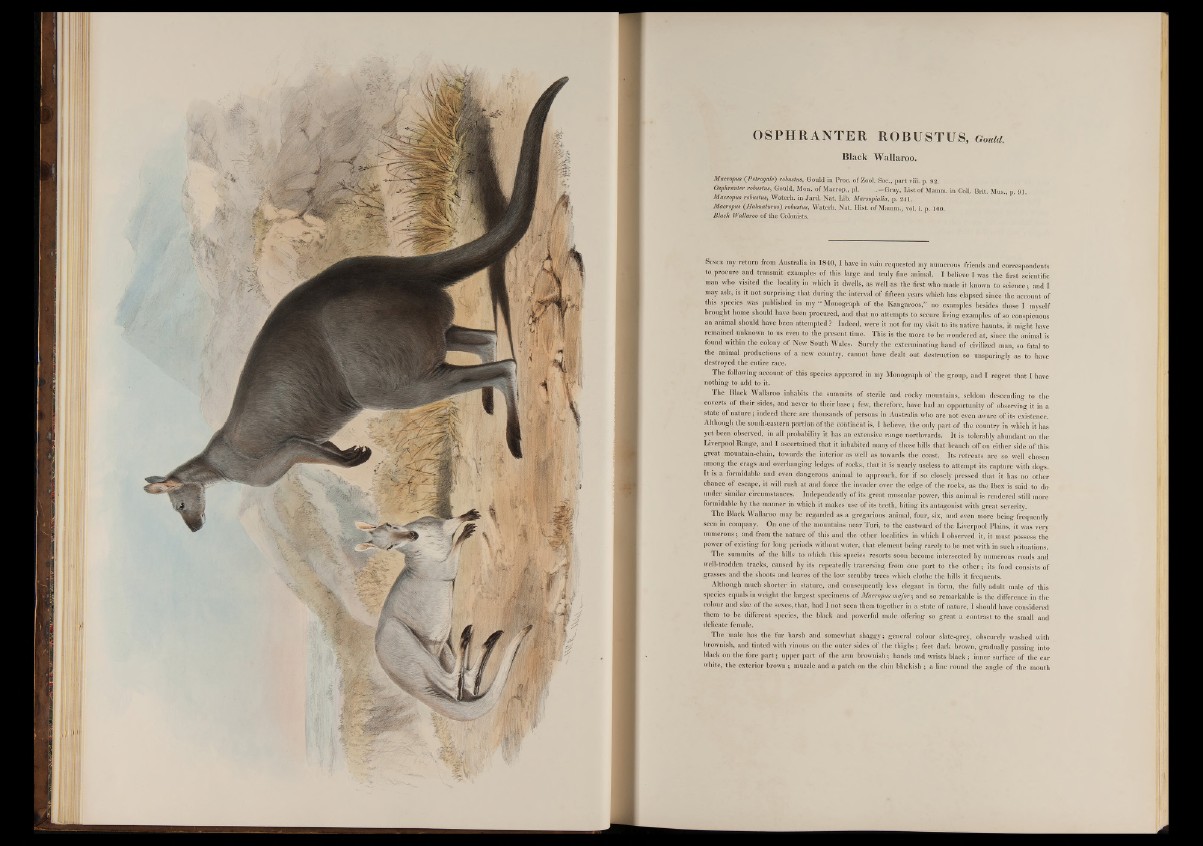
Black Wallaroo.
Macropus (Pétrogale') robustus, Gôuld in Proc. of Zool. Soc., part viii. p. 92.
Osphranter rolustus, Gould, Mon. of Macrop., pl. .-G ra y , List of Mamm. in Coll. Brit. Mus., p. 91.
Macropus robustus, Waterh. in Jard. Nat. Lib. Marsupia lia, p. 241.
Macropus (.Halmaturus) robustus, Waterh. Nat. Hist, of Mamm., vol. i. p. 100.
Black Wallaroo of the Colonists.
Since my return from Australia in 1840, I have in vain requested my numerous friends and correspondents
to procure and transmit, examples of this large and truly fine animal. I believe I was the first scientific
man who visited the locality in which it dwells, as well as the first who made it known to science; and I
may ask, is it not surprising that during the interval of fifteen years which has elapsed since the account of
this species was published in my “ Monograph of the Kangaroos,” no examples besides those I myself
brought home should have been procured, and that no attempts to secure living examples of so conspicuous
an animal should have been attempted ? Indeed, were it not for my visit to its native haunts, it might have
remained unknown to us even to the present time. This is the more to be wondered at, since the animal is
found within the colony of New South Wales. Surely the exterminating hand of civilized man, so fatal to
the animal productions of a new country, cannot have dealt out destruction so unsparingly as to have
destroyed the entire race.
The following account of this species appeared in my Monograph of the group, and I regret that I have
nothing to add to it.
The Black Wallaroo inhabits the summits of sterile and rocky mountains, seldom descending to the
coverts of their sides, and never to their base ; few, therefore, have had an opportunity of observing it in a
state of nature; indeed there are thousands of persons in Australia who are not even aware of its existence.
Although the south-eastern portion of the continent is, I believe, the only part of the country in which it has
yet been observed, in all probability it has an extensive range northwards. It is tolerably abundant on the
Liverpool Range, and I ascertained that it inhabited many of those hills that branch off on either side of this
great mountain-chain, towards the interior as well as towards the coast.. Its retreats are so well chosen
among the crags and overhanging ledges of rocks, that it is nearly useless to attempt its capture with dogs.
It is a formidable and even dangerous animal to approach, for if so closely pressed that it has no other
chance of escape, it will rush at and force the invader over the edge of the rocks, as the Ibex is said to do
under similar circumstances. Independently of its great muscular power, this animal is rendered still more
formidable by the manner in which it makes use of its teeth, biting its antagonist with great severity.
The Black Wallaroo may be regarded as a gregarious animal, four, six, and even more being frequently
seen in company. On one of the mountains near Turi, to the eastward of the Liverpool Plains, it was very
numerous; and from the nature of this and the other localities in which I observed it, it must possess the
power of existing for long periods without water, that element being rarely to be met with in such situations.
The summits of the hills to which this species resorts soon become intersected by numerous roads and
well-trodden tracks, caused by its repeatedly traversing from one part to the other; its food consists of
grasses and the shoots and leaves of the low scrubby trees which clothe the hills it frequents.
Although much shorter in stature, and consequently less elegant in form, the fully adult male of this
species equals in weight the largest specimens of Macropus major; and so remarkable is the difference in the
colour and size of the sexes, that, had I not seen them together in a state of nature, I should have considered
them to be different species, the black and powerful male offering so great a contrast to the small and
delicate female.
The male has the fur harsh and somewhat shaggy; general colour slate-grey, obscurely washed with
brownish, and tinted with vinous on the outer sides of the thighs; feet dark brown, gradually passing into
black on the fore p a rt; upper part of the arm brownish; hands and wrists black ; inner surface of the ear
white, the exterior brown ; muzzle and a patch on the chin blackish ; a line round the angle of the mouth